SOLID principles - Liskov, Interface Segregation, and Dependency Inversion¶
Key Terms¶
Liskov Substitution Principle¶
Objects in a program should be replaceable with instances of their subtypes without altering the correctness of that program.Interface Segregation Principle
Interface Segregation Principle¶
Many client-specific interfaces are better than one general-purpose interface.
Dependency Inversion Principle¶
Depend upon abstractions. Do not depend upon concrete classes.
Liskov Substitution Principle¶
Let us take a look at our final version of the Bird class from the last session fixing ocp violation. We started with a Bird class which had SRP and OCP violations. We now have a Bird abstract class which can be extended by the Eagle , Penguin and Parrot subclasses.
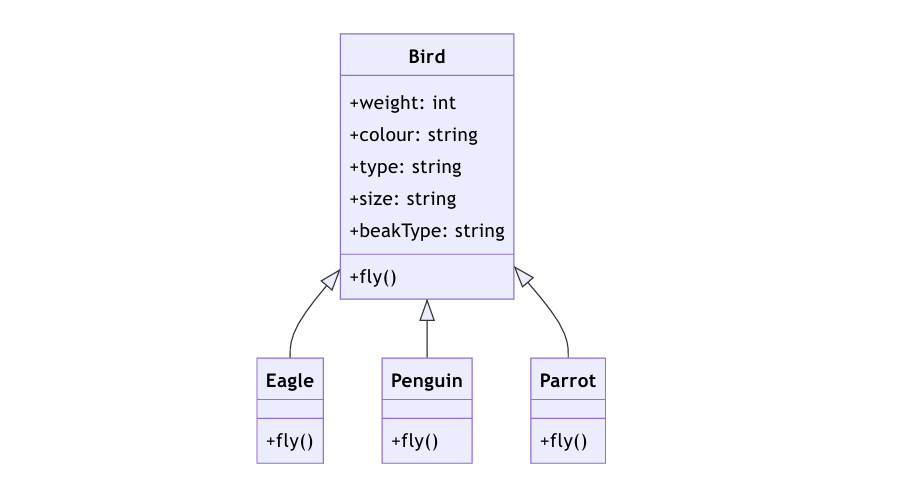
We have also added a fly() method to the Bird class. All the subclasses of Bird have to implement this method. A penguin cannot fly, yet we have added a fly() method to the Penguin class. How can we handle this?
- Dummy method - We can add a dummy method to the Penguin class which does nothing.
- Return null
- Throw an exception
In the above methods, we are trying to force a contract on a class which does not follow it. If we try to use a Penguin object in a place where we expect a Bird object, we could have unexpected outcomes. For example, if we call the fly() method on a Penguin object, we would get an exception. This is not what we want. We want to be able to use a Penguin object in a place where we expect a Bird object. We want to be able to call the fly() method on a Penguin object and get the same result as if we had called it on a Sparrow object. This is where the Liskov Substitution Principle comes into play.
List<Bird> birds = List.of(new Eagle(), new Penguin(), new Parrot());
for (Bird bird : birds) {
bird.fly();
}
This is a violation of the Liskov Substitution Principle. The Liskov Substitution Principle states that objects in a program should be replaceable with instances of their subtypes without altering the correctness of that program. In other words, if we have a Bird object, we should be able to replace it with an instance of its subclasses without altering the correctness of the program. In our case, we cannot replace a Bird object with a Penguin object because the Penguin object requires special handling.
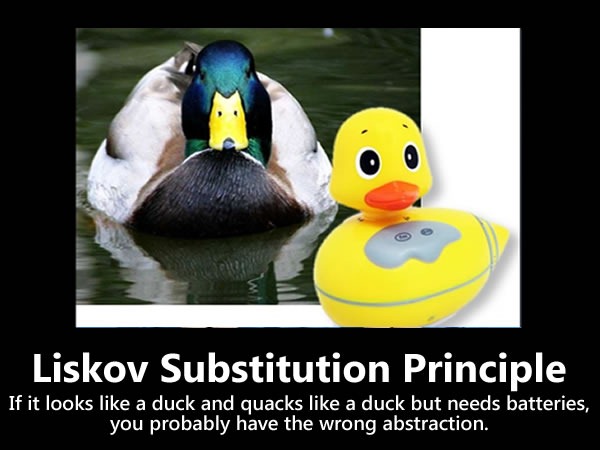
Creating new abstract classes¶
A way to solve the issue with the Penguin class is to create a new set of abstract classes, FlyableBird and NonFlyableBird . The FlyableBird class will have the fly() method and the NonFlyableBird class will not have the fly() method. The Penguin class will extend the NonFlyableBird class and the Eagle and Parrot classes will extend the FlyableBird class. This way, we can ensure that the Penguin class does not have to implement the fly() method.

This is an example of multi-level inheritance. The issue with the above approach is that we are tying behaviour to the class hierarchy. If we want to add a new type of behaviour, we will have to add a new abstract class. For instance if we can have birds that can swim and birds that cannot swim, we will have to create a new abstract class SwimableBird and NonSwimableBird and add them to the class hierarchy. But now how do you extends from two abstract classes? You can't. Then we would have to create classes with composite behaviours such as SwimableFlyableBird and SwimableNonFlyableBird.
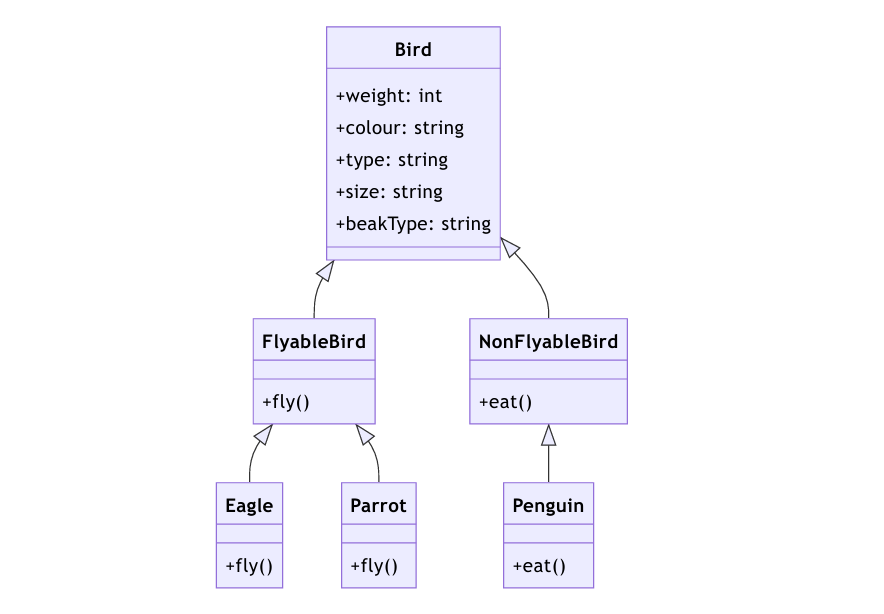
If we want to add a new type of behaviour, we will have to add a new abstract class. This is why we should not tie behaviour to the class hierarchy.
Creating new interfaces¶
We can solve the issue with the Penguin class by creating new interfaces. We can create an Flyable interface and an Swimmable interface. The Penguin class will implement the Swimmable interface and the Eagle and Parrot classes will implement the Flyable interface. This way, we can ensure that the Penguin class does not have to implement the fly() method.
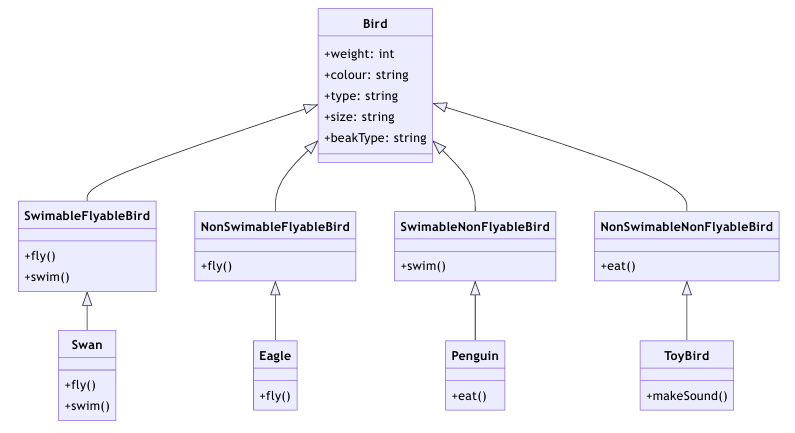
Since we are not tying behaviour to the class hierarchy, we can add new types of behaviour without having to add new abstract classes. For instance, if we want to add a new type of behaviour, we can create a new interface CanSing and add it to the class hierarchy.
Summary¶
The Liskov Substitution Principle states that objects in a program should be replaceable with instances of their subtypes without altering the correctness of that program. To identify violations, we can check if we can replace a class with its subclasses having to handle special cases and expect the same behaviour. Prefer using interfaces over abstract classes to implement behaviour since abstract classes tend to tie behaviour to the class hierarchy.
Interface Segregation Principle¶
Segregation means keeping things separated, and the Interface Segregation Principle is about separating the interfaces.
The principle states that many client-specific interfaces are better than one general purpose interface. Clients should not be forced to implement a function they do no need. Declaring methods in an interface that the client doesnʼt need pollutes the interface and leads to a “bulky” or “fat” interface
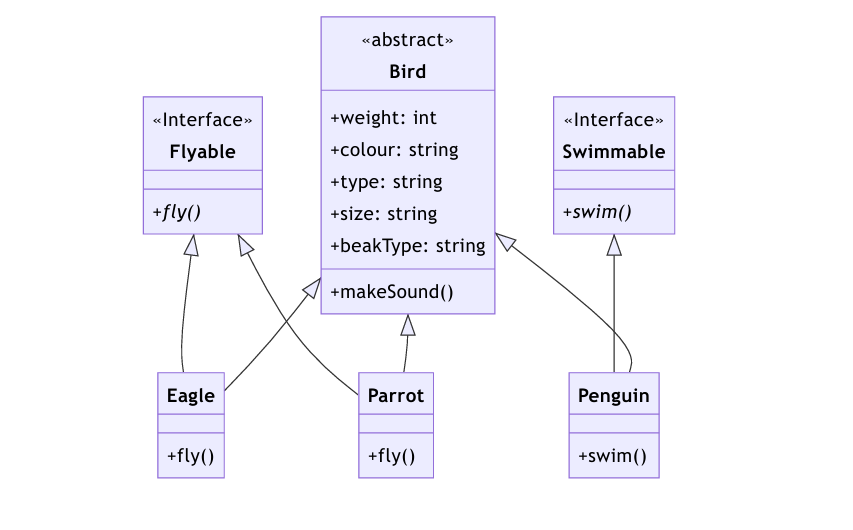
A client should never be forced to implement an interface that it doesnʼt use, or clients shouldnʼt be forced to depend on methods they do not use. In other words, we should not create fat interfaces. A fat interface is an interface that has too many methods. If we have a fat interface, we will have to implement all the methods in the interface even if we donʼt use them. This is known as the interface segregation principle.
Let us take the example of our Bird class. To not tie the behaviour to the class hierarchy, we created an interface Flyable and implemented it in the Eagle and Parrot classes.
public interface Flyable {
void fly();
void makeSound();
}
Along with the fly() method, we also have the makeSound() method in the Flyable interface. This is because the Eagle and Parrot classes both make sounds when they fly. But what if we have a class that implements the Flyable interface? The class does not make a sound when it flies. This is a violation of the interface segregation principle. We should not have the makeSound() method in the Flyable interface.
Larger interfaces should be split into smaller ones. By doing so, we can ensure that implementing classes only need to be concerned about the methods that are of interest to them. If a class exposes so many members that those members can be broken down into groups that serve different clients that donʼt use members from the other groups, you should think about exposing those member groups as separate interfaces.
Precise application design and correct abstraction is the key behind the Interface Segregation Principle. Though it'll take more time and effort in the design phase of an application and might increase the code complexity, in the end, we get a flexible code.
Dependency Inversion Principle¶
The principle of dependency inversion refers to the decoupling of software modules. This way, instead of high-level modules depending on low-level modules, both will depend on abstractions. If the OCP states the goal of OO architecture, the DIP states the primary mechanism for achieving that goal.
The general idea of this principle is as simple as it is important: High-level modules, which provide complex logic, should be easily reusable and unaffected by changes in low-level modules, which provide utility features. To achieve that, you need to introduce an abstraction that decouples the high-level and low-level modules from each other. Dependency inversion principle consists of two parts:
- High-level modules should not depend on low-level modules. Both should depend on abstractions.
- Abstractions should not depend on details. Details should depend on abstractions.

Our bird class looks pretty neat now. We have separated the behaviour into different lean interfaces which are implemented by the classes that need them. When we add new sub classes we identify an issue. For birds that have the same behaviour, we have to implement the same behaviour multiple times.
public class Eagle implements Flyable {
@Override
public void fly() {
System.out.println("Eagle is gliding");
}
}
public class Sparrow implements Flyable {
@Override
public void fly() {
System.out.println("Sparrow is gliding");
}
}
The above can be solved by adding a default method to the Flyable interface. This way, we can avoid code duplication.
But which method should be the default implementation? What if in future we add more birds that have the same behaviour? We will have to change the default implementation or either duplicate the code.
Instead of default implementations, let us abstract the common behaviours to a separate helper classes. We will create a GlidingBehaviour class and a FlappingBehaviour class. The Eagle and Sparrow classes will implement the Flyable interface and use the GlidingBehaviour class. The Parrot class will implement the Flyable interface and use the FlappingBehaviour class.
public class Eagle implements Flyable {
private GlidingBehaviour glidingBehaviour;
public Eagle() {
this.glidingBehaviour = new GlidingBehaviour();
}
@Override
public void fly() {
glidingBehaviour.fly();
}
}
Now we have a problem. The Eagle class is tightly coupled to the GlidingBehaviour class. If we want to change the behaviour of the Eagle class, we will have to open the Eagle class to change the behaviour. This is a violation of the dependency inversion principle. We should not depend on concrete classes. We should depend on abstractions.
Naturally, we rely on interfaces as the abstraction. We create a new interface FlyingBehaviour and implement it in the GlidingBehaviour and FlappingBehaviour classes. The Eagle class will now depend on the FlyingBehaviour interface.
interface FlyingBehaviour{
void fly()
}
class GlidingBehaviour implements FlyingBehaviour{
@Override
public void fly() {
System.out.println("Eagle is gliding");
}
}
...
class Eagle implements Flyable {
private FlyingBehaviour flyingBehaviour;
public Eagle() {
this.flyingBehaviour = new GlidingBehaviour();
}
@Override
public void fly() {
flyingBehaviour.fly();
}
}
